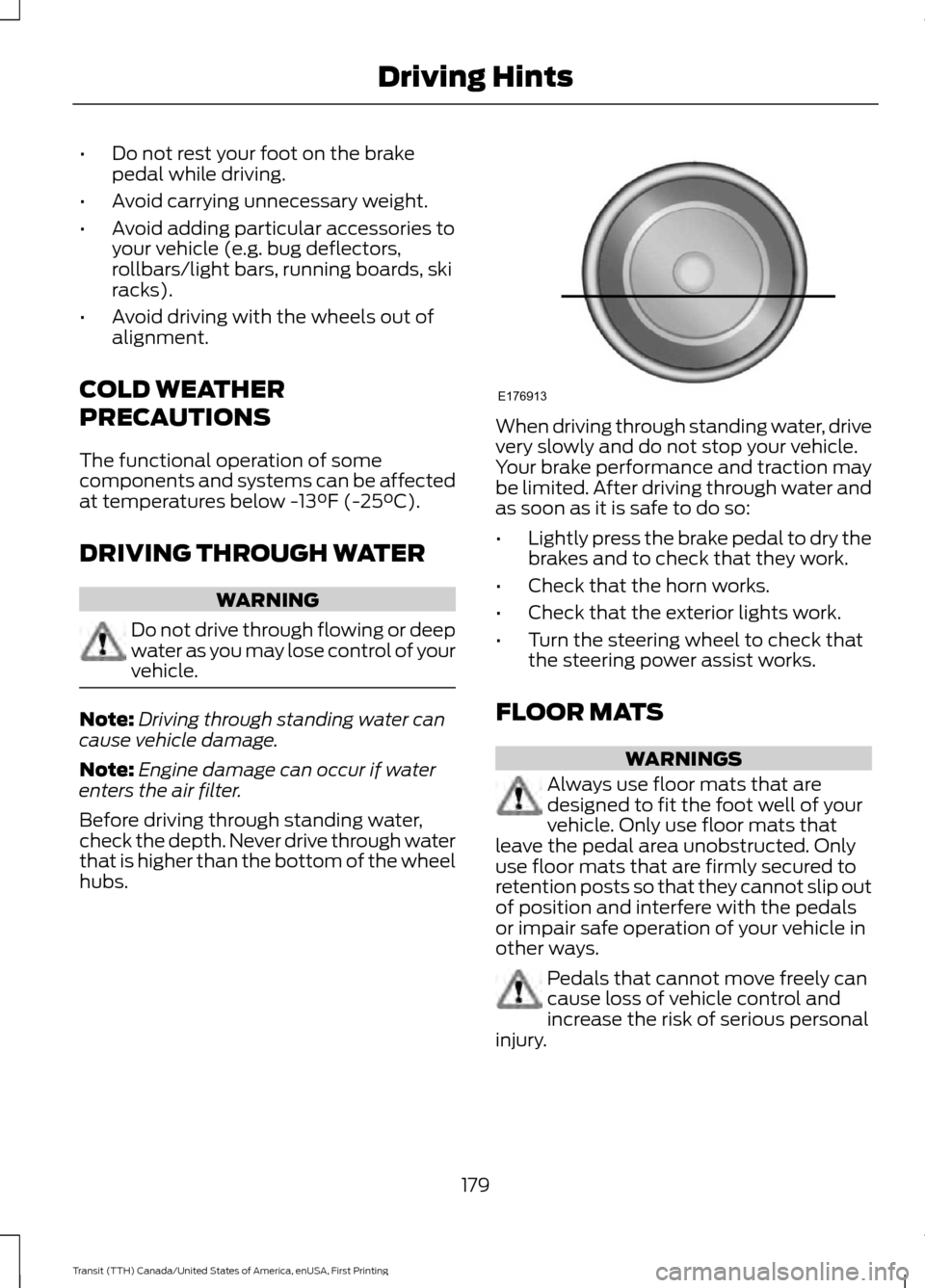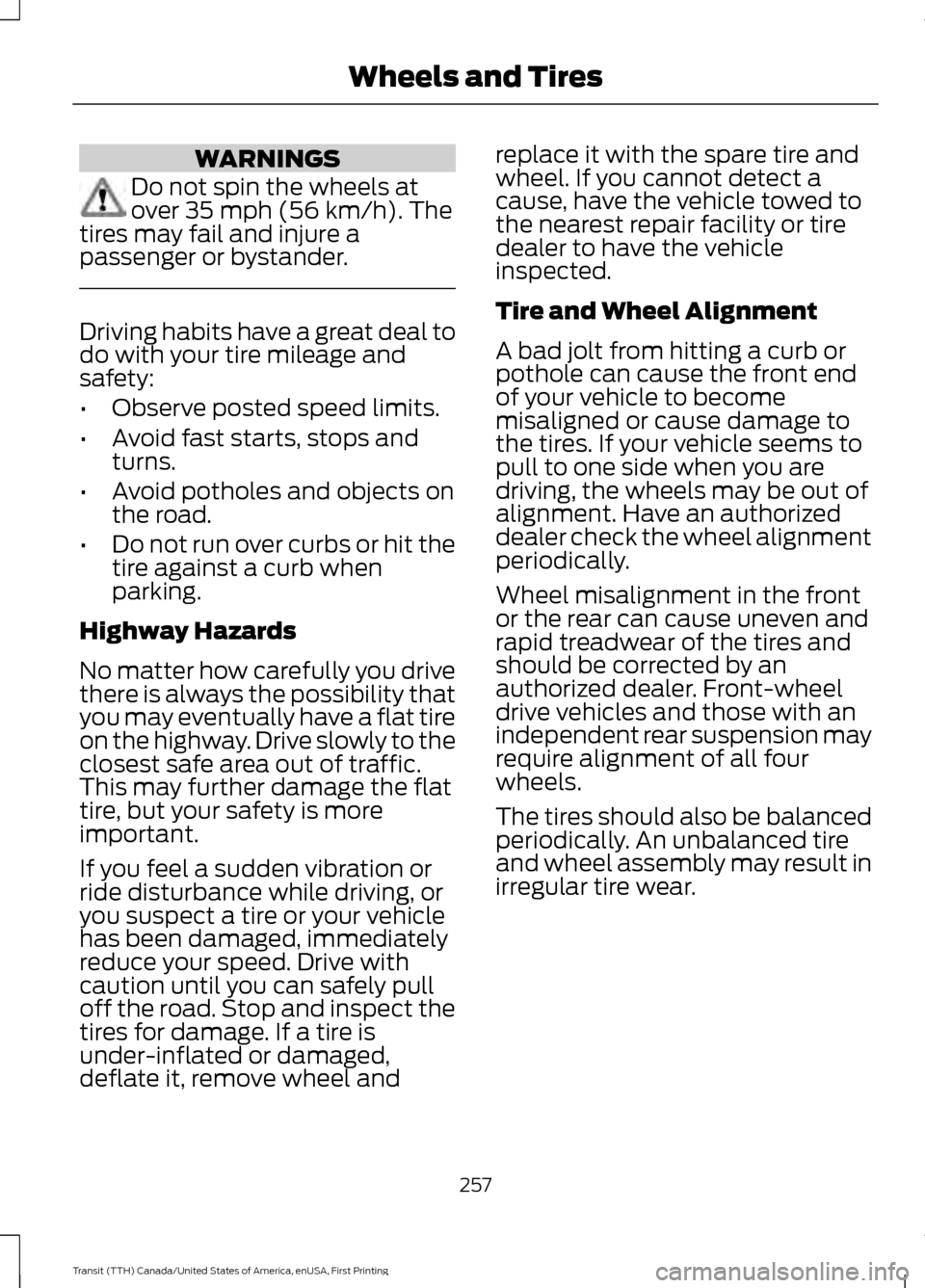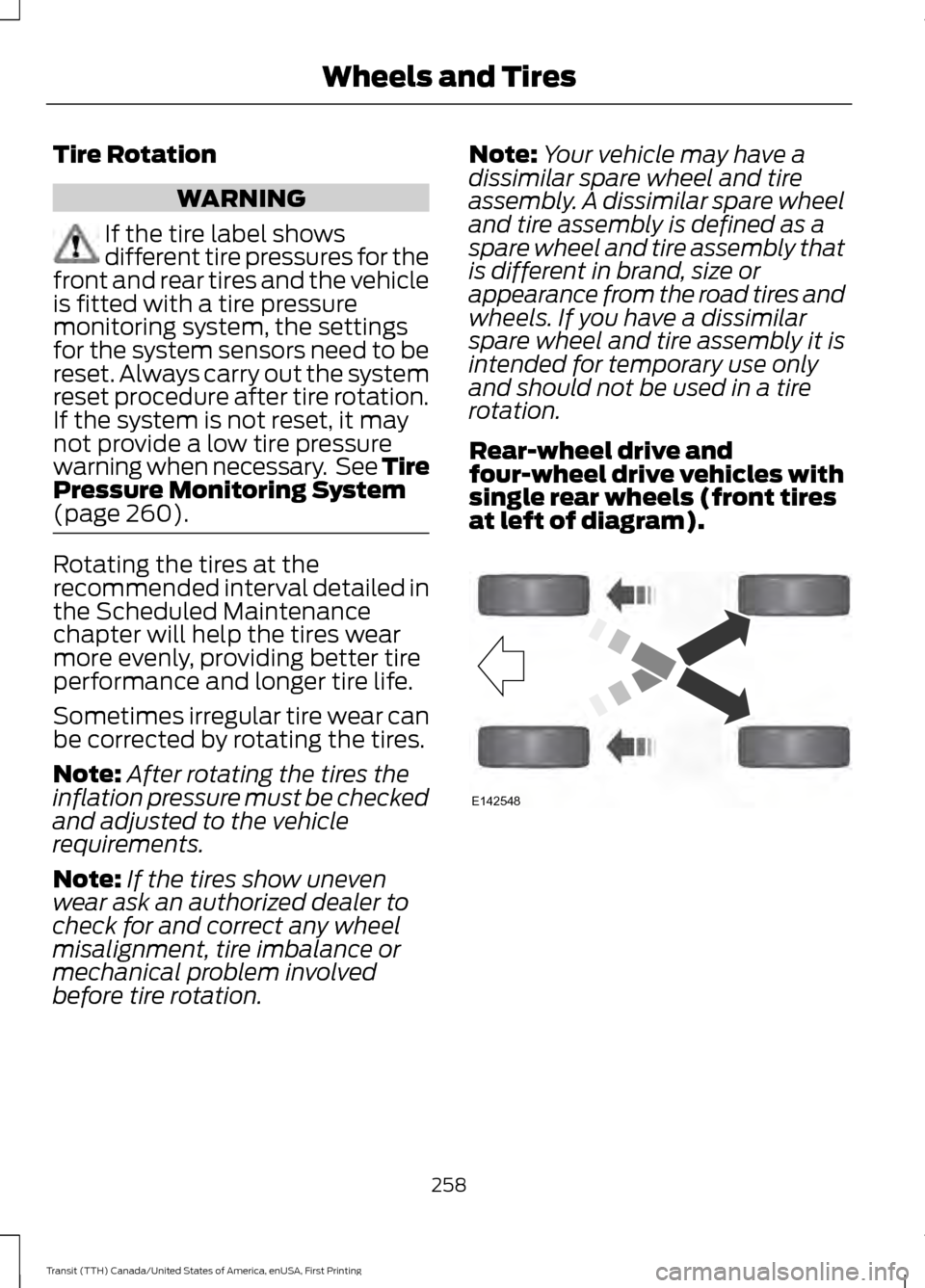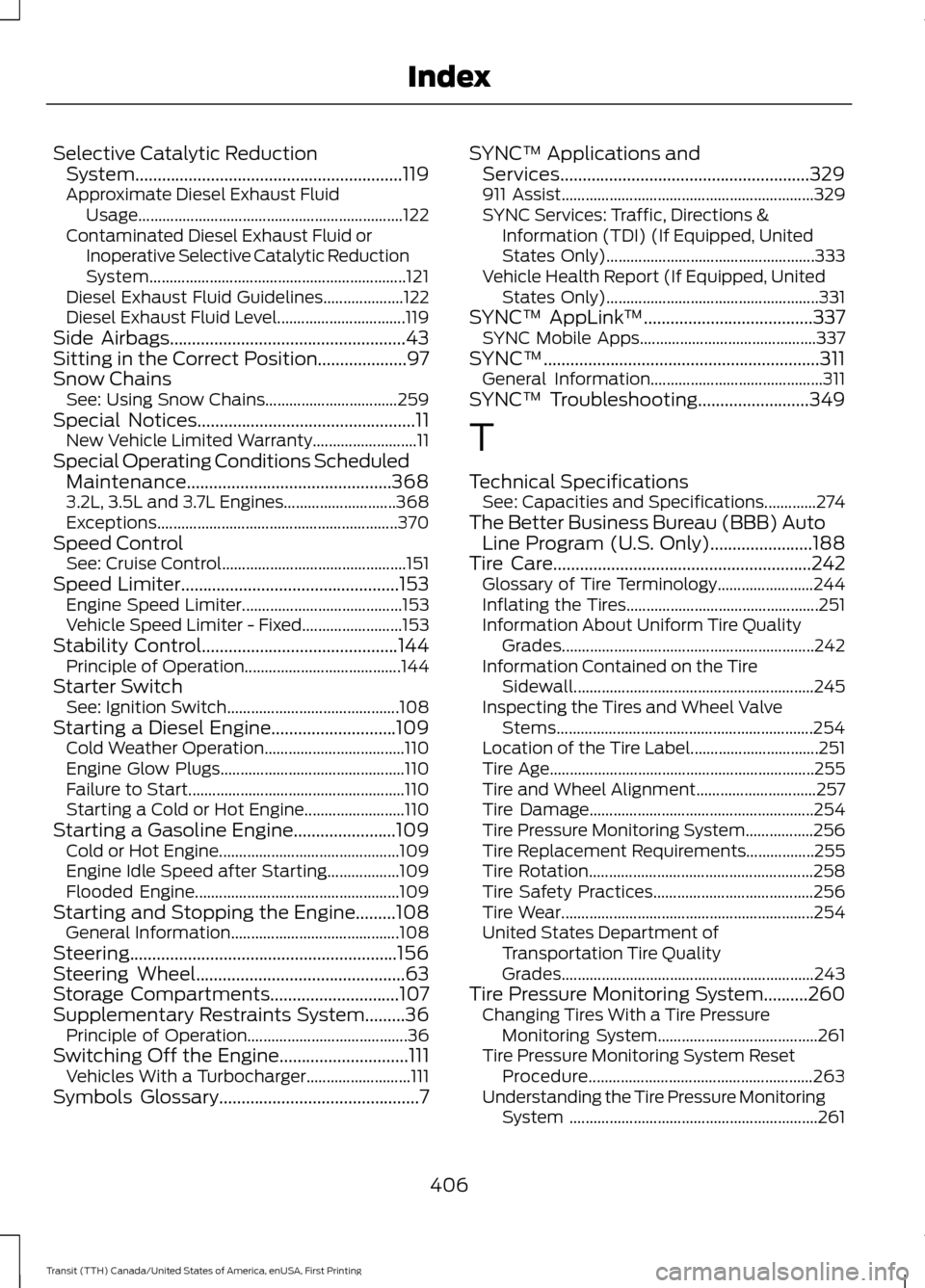wheel alignment FORD TRANSIT 2016 5.G Owners Manual
[x] Cancel search | Manufacturer: FORD, Model Year: 2016, Model line: TRANSIT, Model: FORD TRANSIT 2016 5.GPages: 411, PDF Size: 5.65 MB
Page 182 of 411

•
Do not rest your foot on the brake
pedal while driving.
• Avoid carrying unnecessary weight.
• Avoid adding particular accessories to
your vehicle (e.g. bug deflectors,
rollbars/light bars, running boards, ski
racks).
• Avoid driving with the wheels out of
alignment.
COLD WEATHER
PRECAUTIONS
The functional operation of some
components and systems can be affected
at temperatures below -13°F (-25°C).
DRIVING THROUGH WATER WARNING
Do not drive through flowing or deep
water as you may lose control of your
vehicle.
Note:
Driving through standing water can
cause vehicle damage.
Note: Engine damage can occur if water
enters the air filter.
Before driving through standing water,
check the depth. Never drive through water
that is higher than the bottom of the wheel
hubs. When driving through standing water, drive
very slowly and do not stop your vehicle.
Your brake performance and traction may
be limited. After driving through water and
as soon as it is safe to do so:
•
Lightly press the brake pedal to dry the
brakes and to check that they work.
• Check that the horn works.
• Check that the exterior lights work.
• Turn the steering wheel to check that
the steering power assist works.
FLOOR MATS WARNINGS
Always use floor mats that are
designed to fit the foot well of your
vehicle. Only use floor mats that
leave the pedal area unobstructed. Only
use floor mats that are firmly secured to
retention posts so that they cannot slip out
of position and interfere with the pedals
or impair safe operation of your vehicle in
other ways. Pedals that cannot move freely can
cause loss of vehicle control and
increase the risk of serious personal
injury.
179
Transit (TTH) Canada/United States of America, enUSA, First Printing Driving HintsE176913
Page 260 of 411

WARNINGS
Do not spin the wheels at
over 35 mph (56 km/h). The
tires may fail and injure a
passenger or bystander. Driving habits have a great deal to
do with your tire mileage and
safety:
•
Observe posted speed limits.
• Avoid fast starts, stops and
turns.
• Avoid potholes and objects on
the road.
• Do not run over curbs or hit the
tire against a curb when
parking.
Highway Hazards
No matter how carefully you drive
there is always the possibility that
you may eventually have a flat tire
on the highway. Drive slowly to the
closest safe area out of traffic.
This may further damage the flat
tire, but your safety is more
important.
If you feel a sudden vibration or
ride disturbance while driving, or
you suspect a tire or your vehicle
has been damaged, immediately
reduce your speed. Drive with
caution until you can safely pull
off the road. Stop and inspect the
tires for damage. If a tire is
under-inflated or damaged,
deflate it, remove wheel and replace it with the spare tire and
wheel. If you cannot detect a
cause, have the vehicle towed to
the nearest repair facility or tire
dealer to have the vehicle
inspected.
Tire and Wheel Alignment
A bad jolt from hitting a curb or
pothole can cause the front end
of your vehicle to become
misaligned or cause damage to
the tires. If your vehicle seems to
pull to one side when you are
driving, the wheels may be out of
alignment. Have an authorized
dealer check the wheel alignment
periodically.
Wheel misalignment in the front
or the rear can cause uneven and
rapid treadwear of the tires and
should be corrected by an
authorized dealer. Front-wheel
drive vehicles and those with an
independent rear suspension may
require alignment of all four
wheels.
The tires should also be balanced
periodically. An unbalanced tire
and wheel assembly may result in
irregular tire wear.
257
Transit (TTH) Canada/United States of America, enUSA, First Printing Wheels and Tires
Page 261 of 411

Tire Rotation
WARNING
If the tire label shows
different tire pressures for the
front and rear tires and the vehicle
is fitted with a tire pressure
monitoring system, the settings
for the system sensors need to be
reset. Always carry out the system
reset procedure after tire rotation.
If the system is not reset, it may
not provide a low tire pressure
warning when necessary. See Tire
Pressure Monitoring System
(page 260). Rotating the tires at the
recommended interval detailed in
the Scheduled Maintenance
chapter will help the tires wear
more evenly, providing better tire
performance and longer tire life.
Sometimes irregular tire wear can
be corrected by rotating the tires.
Note:
After rotating the tires the
inflation pressure must be checked
and adjusted to the vehicle
requirements.
Note: If the tires show uneven
wear ask an authorized dealer to
check for and correct any wheel
misalignment, tire imbalance or
mechanical problem involved
before tire rotation. Note:
Your vehicle may have a
dissimilar spare wheel and tire
assembly. A dissimilar spare wheel
and tire assembly is defined as a
spare wheel and tire assembly that
is different in brand, size or
appearance from the road tires and
wheels. If you have a dissimilar
spare wheel and tire assembly it is
intended for temporary use only
and should not be used in a tire
rotation.
Rear-wheel drive and
four-wheel drive vehicles with
single rear wheels (front tires
at left of diagram). 258
Transit (TTH) Canada/United States of America, enUSA, First Printing Wheels and TiresE142548
Page 409 of 411

Selective Catalytic Reduction
System............................................................119
Approximate Diesel Exhaust Fluid
Usage.................................................................. 122
Contaminated Diesel Exhaust Fluid or Inoperative Selective Catalytic Reduction
System................................................................ 121
Diesel Exhaust Fluid Guidelines.................... 122
Diesel Exhaust Fluid Level................................ 119
Side Airbags
.....................................................43
Sitting in the Correct Position....................97
Snow Chains See: Using Snow Chains................................. 259
Special Notices
.................................................11
New Vehicle Limited Warranty.......................... 11
Special Operating Conditions Scheduled Maintenance..............................................368
3.2L, 3.5L and 3.7L Engines............................ 368
Exceptions............................................................ 370
Speed Control See: Cruise Control.............................................. 151
Speed Limiter.................................................153 Engine Speed Limiter........................................ 153
Vehicle Speed Limiter - Fixed......................... 153
Stability Control
............................................144
Principle of Operation....................................... 144
Starter Switch See: Ignition Switch........................................... 108
Starting a Diesel Engine
............................109
Cold Weather Operation................................... 110
Engine Glow Plugs.............................................. 110
Failure to Start...................................................... 110
Starting a Cold or Hot Engine......................... 110
Starting a Gasoline Engine.......................109 Cold or Hot Engine............................................. 109
Engine Idle Speed after Starting.................. 109
Flooded Engine................................................... 109
Starting and Stopping the Engine.........108 General Information.......................................... 108
Steering............................................................156
Steering Wheel
...............................................63
Storage Compartments.............................107
Supplementary Restraints System.........36 Principle of Operation........................................ 36
Switching Off the Engine.............................111 Vehicles With a Turbocharger.......................... 111
Symbols Glossary
.............................................7 SYNC™ Applications and
Services........................................................329
911 Assist............................................................... 329
SYNC Services: Traffic, Directions & Information (TDI) (If Equipped, United
States Only).................................................... 333
Vehicle Health Report (If Equipped, United States Only)..................................................... 331
SYNC™ AppLink ™
......................................337
SYNC Mobile Apps............................................ 337
SYNC™..............................................................311 General Information........................................... 311
SYNC™ Troubleshooting
.........................349
T
Technical Specifications See: Capacities and Specifications.............274
The Better Business Bureau (BBB) Auto Line Program (U.S. Only).......................188
Tire Care
..........................................................242
Glossary of Tire Terminology........................ 244
Inflating the Tires................................................ 251
Information About Uniform Tire Quality Grades............................................................... 242
Information Contained on the Tire Sidewall............................................................ 245
Inspecting the Tires and Wheel Valve Stems................................................................ 254
Location of the Tire Label................................ 251
Tire Age.................................................................. 255
Tire and Wheel Alignment.............................. 257
Tire Damage........................................................ 254
Tire Pressure Monitoring System.................256
Tire Replacement Requirements.................255
Tire Rotation........................................................ 258
Tire Safety Practices........................................ 256
Tire Wear............................................................... 254
United States Department of Transportation Tire Quality
Grades............................................................... 243
Tire Pressure Monitoring System..........260 Changing Tires With a Tire Pressure
Monitoring System........................................ 261
Tire Pressure Monitoring System Reset Procedure........................................................ 263
Understanding the Tire Pressure Monitoring System .............................................................. 261
406
Transit (TTH) Canada/United States of America, enUSA, First Printing Index